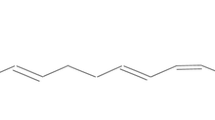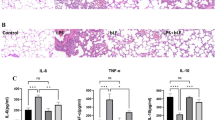Abstract
This study was aimed at investigating the effect of etomidate on the viability of rat macrophages and the function of lipopolysaccharide (LPS)-stimulated macrophages as well as the potential mechanisms. Rat macrophages were isolated and treated with different doses of etomidate for 24 h, and their viability was determined by the CCK-8 assay. Furthermore, macrophages were treated with, or without, 1 μg/ml of LPS, and/or 2.5 or 5 μM etomidate in the presence or absence of a TREM-1 inhibitor (LP17, 100 ng/ml), and the levels of TNF-α, IL-6, CD14, and TREM-1 in the different groups of cells were determined by quantitative RT-PCR, ELISA, and Western blot assays. The levels of NF-κB activation in the different groups of cells were analyzed by an electrophoretic mobility shift assay (EMSA). Etomidate at 31.25 μM or a low dose did not affect the viability of rat macrophages, while etomidate at higher doses reduced the viability of macrophages in vitro. Treatment with 2.5 or 5 μM etomidate or with LP17 alone did not affect the levels of TNF-α, IL-6, CD-14, and TREM-1 in macrophages. Treatment with etomidate significantly mitigated LPS-stimulated TNF-α, IL-6, CD-14, and TREM-1 expression (p < 0.05 for all) and inhibited LPS-induced NF-κB activation in macrophages in vitro. However, treatment with both etomidate and LP17 did not enhance the inhibitory effects in macrophages. Hence, etomidate mitigates LPS-up-regulated pro-inflammatory cytokine production and inhibits LPS-enhanced CD14 and TREM-1 expression and NF-κB activation in macrophages.





Similar content being viewed by others
References
Du, B., Y. An, Y. Kang, X. Yu, M. Zhao, X. Ma, et al. 2013. Characteristics of critically ill patients in ICUs in mainland China. Critical Care Medicine 41: 84–92.
Forman, S.A. 2011. Clinical and molecular pharmacology of etomidate. Anesthesiology 114: 695–707.
Chan, C.M., A.L. Mitchell, and A.F. Shorr. 2012. Etomidate is associated with mortality and adrenal insufficiency in sepsis: a meta-analysis*. Critical Care Medicine 40: 2945–2953.
Zhang, Y., R. Li, J. Zhu, Z. Wang, S. Lv, and J.Y. Xiong. 2015. Etomidate increases mortality in septic rats through inhibition of nuclear factor kappa-B rather than by causing adrenal insufficiency. The Journal of Surgical Research 193: 399–406.
Rittirsch, D., M.A. Flierl, and P.A. Ward. 2008. Harmful molecular mechanisms in sepsis. Nature Reviews Immunology 8: 776–787.
Rossol, M., H. Heine, U. Meusch, D. Quandt, C. Klein, M.J. Sweet, et al. 2011. LPS-induced cytokine production in human monocytes and macrophages. Critical Reviews in Immunology 31: 379–446.
Bryant, C.E., D.R. Spring, M. Gangloff, and N.J. Gay. 2010. The molecular basis of the host response to lipopolysaccharide. Nature Reviews Microbiology 8: 8–14.
Bouchon, A., F. Facchetti, M.A. Weigand, and M. Colonna. 2001. TREM-1 amplifies inflammation and is a crucial mediator of septic shock. Nature 410: 1103–1107.
Gibot, S., M.N. Kolopp-Sarda, M.C. Bene, P.E. Bollaert, A. Lozniewski, F. Mory, et al. 2004. A soluble form of the triggering receptor expressed on myeloid cells-1 modulates the inflammatory response in murine sepsis. The Journal of Experimental Medicine 200: 1419–1426.
Gibot, S., C. Buonsanti, F. Massin, M. Romano, M.N. Kolopp-Sarda, F. Benigni, et al. 2006. Modulation of the triggering receptor expressed on the myeloid cell type 1 pathway in murine septic shock. Infection and Immunity 74: 2823–2830.
Gibot, S., C. Alauzet, F. Massin, N. Sennoune, G.C. Faure, M.C. Bene, et al. 2006. Modulation of the triggering receptor expressed on myeloid cells-1 pathway during pneumonia in rats. The Journal of Infectious Diseases 194: 975–983.
Gibot, S., F. Massin, C. Alauzet, C. Montemont, A. Lozniewski, P.E. Bollaert, et al. 2008. Effects of the TREM-1 pathway modulation during mesenteric ischemia-reperfusion in rats. Critical Care Medicine 36: 504–510.
Schenk, M., A. Bouchon, F. Seibold, and C. Mueller. 2007. TREM-1—expressing intestinal macrophages crucially amplify chronic inflammation in experimental colitis and inflammatory bowel diseases. The Journal of Clinical Investigation 117: 3097–3106.
Liu, S., X. Zhu, Y. Liu, C. Wang, S. Wang, X. Tang, et al. 2011. Endotoxin tolerance of adrenal gland: attenuation of corticosterone production in response to lipopolysaccharide and Adrenocorticotropic hormone. Critical Care Medicine 39: 518–526.
Wu, R.S., K.C. Wu, J.S. Yang, S.M. Chiou, C.S. Yu, S.J. Chang, et al. 2011. Etomidate induces cytotoxic effects and gene expression in a murine leukemia macrophage cell line (RAW264.7). Anticancer Research 31: 2203–2208.
Zhang, X., J. Xiong, Y. Jiao, G. Wang, and Z. Zuo. 2010. Involvement of mitochondrial ATP-sensitive potassium channels in etomidate preconditioning-induced protection in human myeloid HL-60 cells. Environmental Toxicology and Pharmacology 29: 320–322.
Nathan, C. 2002. Points of control in inflammation. Nature 420: 846–852.
Wu, G.J., T.L. Chen, Y.F. Ueng, and R.M. Chen. 2008. Ketamine inhibits tumor necrosis factor-alpha and interleukin-6 gene expressions in lipopolysaccharide-stimulated macrophages through suppression of toll-like receptor 4-mediated c-Jun N-terminal kinase phosphorylation and activator protein-1 activation. Toxicology and Applied Pharmacology 228: 105–113.
Wu, G.J., T.L. Chen, C.C. Chang, and R.M. Chen. 2009. Propofol suppresses tumor necrosis factor-alpha biosynthesis in lipopolysaccharide-stimulated macrophages possibly through downregulation of nuclear factor-kappa B-mediated toll-like receptor 4 gene expression. Chemico-Biological Interactions 180: 465–471.
Schulz, M., and A. Schmoldt. 2003. Therapeutic and toxic blood concentrations of more than 800 drugs and other xenobiotics. Die Pharmazie 58: 447–474.
Chiche, L., J.M. Forel, G. Thomas, C. Farnarier, F. Vely, M. Blery, et al. 2011. The role of natural killer cells in sepsis. Journal of Biomedicine & Biotechnology 2011: 986491.
Liu, Z.G. 2005. Molecular mechanism of TNF signaling and beyond. Cell Research 15: 24–27.
Jawan, B., Y.H. Kao, S. Goto, M.C. Pan, Y.C. Lin, L.W. Hsu, et al. 2008. Propofol pretreatment attenuates LPS-induced granulocyte-macrophage colony-stimulating factor production in cultured hepatocytes by suppressing MAPK/ERK activity and NF-kappaB translocation. Toxicology and Applied Pharmacology 229: 362–373.
Hayashi, T., M. Kishiwada, K. Fujii, H. Yuasa, J. Nishioka, M. Ido, et al. 2006. Lipopolysaccharide-induced decreased protein S expression in liver cells is mediated by MEK/ERK signaling and NFkappaB activation: involvement of membrane-bound CD14 and toll-like receptor-4. Journal of Thrombosis and Haemostasis: JTH 4: 1763–1773.
Haselmayer, P., L. Grosse-Hovest, P. von Landenberg, H. Schild, and M.P. Radsak. 2007. TREM-1 ligand expression on platelets enhances neutrophil activation. Blood 110: 1029–1035.
Netea, M.G., T. Azam, G. Ferwerda, S.E. Girardin, S.H. Kim, and C.A. Dinarello. 2006. Triggering receptor expressed on myeloid cells-1 (TREM-1) amplifies the signals induced by the NACHT-LRR (NLR) pattern recognition receptors. Journal of Leukocyte Biology 80: 1454–1461.
Fortin, C.F., O. Lesur, and T. Fulop Jr. 2007. Effects of aging on triggering receptor expressed on myeloid cells (TREM)-1-induced PMN functions. FEBS Letters 581: 1173–1178.
Gibot, S., F. Massin, M. Marcou, V. Taylor, R. Stidwill, P. Wilson, et al. 2007. TREM-1 promotes survival during septic shock in mice. European Journal of Immunology 37: 456–466.
Ornatowska, M., A.C. Azim, X. Wang, J.W. Christman, L. Xiao, M. Joo, et al. 2007. Functional genomics of silencing TREM-1 on TLR4 signaling in macrophages. American Journal of Physiology. Lung Cellular and Molecular Physiology 293: L1377–L1384.
Zeng, H., M. Ornatowska, M.S. Joo, and R.T. Sadikot. 2007. TREM-1 expression in macrophages is regulated at transcriptional level by NF-kappaB and PU.1. European Journal of Immunology 37: 2300–2308.
Sanders, R.D., A. Godlee, T. Fujimori, J. Goulding, G. Xin, S. Salek-Ardakani, et al. 2013. Benzodiazepine augmented gamma-amino-butyric acid signaling increases mortality from pneumonia in mice. Critical Care Medicine 41: 1627–1636.
Tian, J., C. Chau, T.G. Hales, and D.L. Kaufman. 1999. GABA(A) receptors mediate inhibition of T cell responses. Journal of Neuroimmunology 96: 21–28.
Bhat, R., R. Axtell, A. Mitra, M. Miranda, C. Lock, R.W. Tsien, et al. 2010. Inhibitory role for GABA in autoimmune inflammation. Proceedings of the National Academy of Sciences of the United States of America 107: 2580–2585.
Acknowledgments
This work was supported by a grant from the National Natural Science Foundation of China (no. 81171791).
Conflict of Interest
The authors declare no conflicts of interest.
Author information
Authors and Affiliations
Corresponding author
Rights and permissions
About this article
Cite this article
Liu, M., Zhang, Y., Xiong, JY. et al. Etomidate Mitigates Lipopolysaccharide-Induced CD14 and TREM-1 Expression, NF-κB Activation, and Pro-inflammatory Cytokine Production in Rat Macrophages. Inflammation 39, 327–335 (2016). https://doi.org/10.1007/s10753-015-0253-7
Published:
Issue Date:
DOI: https://doi.org/10.1007/s10753-015-0253-7




